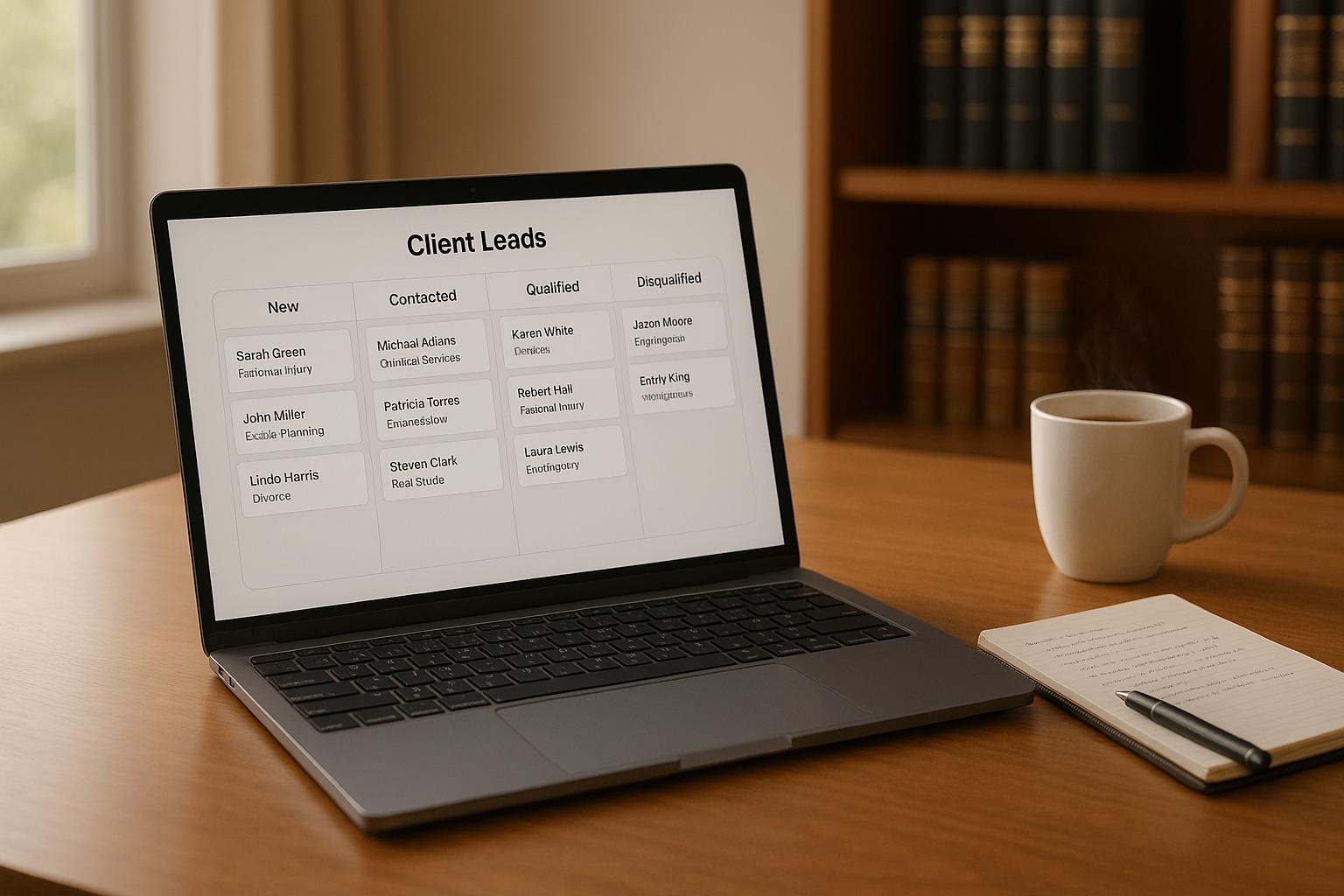How to Automate Law Firm Lead Qualification

Law firms waste hours chasing unqualified leads or responding too slowly to potential clients. Automation solves this problem by qualifying leads 24/7, saving time and improving client conversion rates.
Here’s how automation transforms lead qualification:
- 24/7 Client Intake: Automated systems collect inquiries anytime - via chat, forms, or text - ensuring no lead is missed, even after hours.
- AI-Driven Scoring: Leads are ranked based on criteria like case strength, urgency, or budget, prioritizing high-value opportunities.
- Seamless Integration: Tools sync with practice management systems to create case files, schedule follow-ups, and reduce manual work.
- Improved Efficiency: Automation eliminates repetitive tasks, allowing attorneys to focus on viable cases.
For example, platforms like Serva offer multilingual support, automated follow-ups, and real-time notifications, ensuring potential clients are engaged quickly and efficiently.
Key Metrics to Track Success:
- Lead conversion rates
- Response times
- Cost per qualified lead
- Attorney time allocation
Compliance Matters: Automated systems must protect client data, follow state bar ethics, and integrate conflict checks to maintain legal standards.
Automation is not just about saving time - it ensures every lead is handled consistently and professionally, helping law firms grow while reducing operational strain.
Automating Lead Qualification, Intake, and Document Generation With Gavel and Lawcus

Core Features of Automated Lead Qualification
Modern automated lead qualification tools are reshaping how law firms manage potential clients. These systems streamline the process by capturing, evaluating, and routing leads more efficiently than traditional manual methods.
24/7 Automated Client Intake
One of the most obvious advantages of automation is its round-the-clock availability. Legal emergencies don’t stick to business hours, and your intake process shouldn’t either. Automated systems ensure that every inquiry, no matter the time, is addressed promptly.
These tools handle initial contact across multiple platforms - whether it’s through web forms, chatbots, phone calls, or text messages. For example, if an inquiry comes in at 2 a.m., the system immediately collects crucial case details without delay.
Multilingual capabilities expand your firm's accessibility, allowing intake interviews in various languages without needing bilingual staff available at all hours.
Consistency is another key benefit. Automated systems follow a set script, asking the same questions in the same order every time. Unlike human staff, who might overlook important details - like statute of limitations issues - during busy periods, these systems ensure comprehensive data collection every time.
Smart Lead Scoring and Qualification
After intake, AI-driven lead scoring steps in to prioritize leads more effectively. This feature evaluates potential clients based on your firm’s specific criteria, assigning scores that reflect factors like case strength, potential value, and likelihood of retention.
For instance, leads with clear liability, extensive treatment needs, and strong insurance coverage receive higher scores. High-value cases are flagged for immediate attorney review, while lower-priority matters are routed to paralegals or scheduled for follow-up.
Automated disqualification is another time-saver. Inquiries that don’t meet your firm’s criteria are filtered out instantly, sparing your staff from spending time on unviable leads.
What’s more, these systems learn over time. Using machine learning, they analyze your firm’s historical data to refine scoring accuracy. They also factor in urgency - cases involving an impending court deadline or expiring statute of limitations are prioritized, ensuring critical matters get immediate attention.
Integration with Practice Management Systems
Efficiency gets a significant boost when these automated systems integrate seamlessly with your practice management software. This eliminates redundant data entry and streamlines the transition from lead to client. For example, once a lead is qualified, the system can automatically create a new matter file, populate client details, and schedule follow-up tasks - no manual steps required.
Real-time synchronization ensures lead information flows smoothly into your system, triggering tasks like email alerts, appointment scheduling, and document generation. By the time an attorney reaches out to a qualified lead, everything - conflict checks, preliminary case notes, and client details - is already organized in the firm's standard format.
Document automation becomes a breeze. Engagement letters, fee agreements, and initial pleadings can be pre-filled with data collected during intake, cutting down the time between first contact and case initiation.
Calendar integration further simplifies operations. Follow-up calls and consultations are automatically scheduled based on lead priority and attorney availability. High-priority cases might get same-day callbacks, while less urgent matters are booked in the next available slot.
Finally, reporting and analytics gain precision when intake data integrates with practice management systems. Firms can track performance metrics like conversion rates, identify which marketing sources bring in the most valuable clients, and fine-tune their intake process based on hard data. This level of insight helps firms make smarter, data-driven decisions.
Step-by-Step Implementation Guide
Rolling out automated lead qualification requires a structured approach to avoid inefficiencies and unnecessary costs. Below is a detailed guide to help you evaluate, implement, and fine-tune your automation strategy effectively.
Assess Your Firm's Needs and Goals
Start by auditing your current lead qualification process. Look at how accurate it is, how well leads convert to clients, and how quickly responses are sent out. This baseline data is crucial for understanding how AI can improve your process and estimating its potential return on investment.
Compare your performance to industry benchmarks. For example, in 2025, 74% of law firms responded to online leads within seven days, with a median response time of 13 minutes. However, only half of firms managed to respond within an hour, even though clients expect faster engagement. On average, law firms need about 13.4 leads to land one client, but firms that align campaigns with their practice areas can achieve conversion rates as high as 20–30%.
Understanding your cost per lead (CPL) is also key. For instance, personal injury leads typically cost $150–$500, criminal defense leads range from $50–$200, and mass tort leads often exceed $1,000. Compare these figures to your current expenses to identify where better qualification could save money.
Pinpoint specific pain points in your current system. Common issues include slow response times, manual screening that wastes resources, and difficulty determining which marketing efforts yield viable cases. Document these problems with real examples and timelines to guide your improvements.
Evaluate your data readiness. Check the quality of your CRM data, website analytics, and marketing automation systems. AI systems need consistent data on the entire sales cycle, well-defined outcomes, and accurate lead source tracking.
Finally, set clear and measurable success metrics. These might include faster response times, higher conversion rates, or reduced manual effort. Clear goals will help you choose the right automation tools and measure their impact.
Set Up and Implement Your Automation Solution
Once you've identified your needs, it's time to implement your automation system. Start by ensuring your intake process collects all the necessary qualification data.
Configure the system to automatically score leads, prioritize high-value cases, and filter out unqualified inquiries. Integrating the system with your practice management software can simplify workflows by automatically creating new client files, filling in details, and assigning follow-up tasks. This reduces the risk of leads slipping through the cracks.
Set rules to disqualify leads that fall outside your practice areas or involve expired deadlines. Additionally, integrate a calendar system to make scheduling appointments easier. This ensures urgent cases are addressed promptly while routine consultations are handled efficiently.
Before going live, thoroughly test the system. Run sample leads through the process to confirm that scoring algorithms work as expected, integrations are seamless, and notifications reach the right team members.
Monitor and Optimize Performance
After implementation, ongoing monitoring is essential to maintain the system's effectiveness. Track key metrics like response times, conversion rates, and the accuracy of lead scoring to identify areas for improvement.
Regularly review how the system qualifies leads and adjust the algorithm as needed to better identify high-quality prospects. Keep an eye on false positives and false negatives. Traditional manual qualification often results in 75–85% false positives and 10–20% false negatives, while AI systems can lower these rates to 40–60% and 5–15%, respectively. If your numbers exceed these benchmarks, revisit your criteria and make adjustments.
Fine-tune your AI scoring model using real-time data. Also, analyze response time metrics to spot any delays, as even with automation, slow human follow-up can hurt conversion rates.
Finally, document your return on investment by comparing pre- and post-implementation metrics. This might include time saved, better conversion rates, and lower client acquisition costs.
Getting Results with Serva - 24/7 AI Powered Legal Intake

Serva's Lead Qualification Features
Serva’s AI-driven platform ensures your firm never misses an opportunity, thanks to its 24/7 client intake system. Whether it’s the middle of the night or a holiday, inquiries are captured and addressed promptly, keeping potential clients engaged at all times.
Its multilingual capabilities open doors to a broader audience by overcoming language barriers, making your firm accessible to more people.
The platform’s intelligent case screening stands out by identifying high-value cases that align with your firm’s expertise. It evaluates inquiries based on your practice areas and case criteria, filtering out leads that don’t meet your standards. This ensures your team spends time on the most promising prospects.
Serva also keeps qualified leads engaged through its smart follow-up system. Automated sequences track interactions and adjust follow-ups to maintain interest and momentum with potential clients.
Automated notifications are another game-changer. Your team is instantly alerted when high-priority leads require attention, ensuring you can respond quickly to the most valuable opportunities.
And here’s the best part: Serva integrates seamlessly with your existing practice management tools. Qualified lead data flows directly into your CRM, eliminating manual data entry and reducing the chance of errors.
These features create a streamlined and efficient workflow, but to get the most out of Serva, it’s essential to follow a few key best practices.
Best Practices for Using Serva
To fully tap into Serva's potential, here are some practical steps your firm can take:
- Set clear qualification criteria: Define case types, geographic limits, and minimum case values that align with your firm’s goals. This ensures you’re targeting the right leads from the start.
- Tailor intake questionnaires: Customize forms for each practice area to collect relevant details upfront. For instance, focus on accident specifics for personal injury cases or custody details for family law matters.
- Train your team: While AI handles much of the heavy lifting, human judgment is critical. Make sure your team knows how to interpret Serva’s lead reports to make informed decisions about case acceptance.
- Fine-tune follow-up timing: Study response patterns to determine when leads are most likely to engage. Adjust your follow-up strategies to align with these insights for better results.
- Streamline consultations: Use Serva’s scheduling integration to sync attorney availability with client bookings. This ensures urgent cases get immediate attention while routine matters are handled efficiently.
- Refine settings regularly: Review and update qualification criteria based on actual case outcomes. If certain traits consistently predict successful cases, adjust Serva’s settings to prioritize those factors.
- Route inquiries smartly: Use Serva’s triage tools to direct leads to the right team members. Assigning specialized cases to the appropriate attorneys boosts response quality and conversion rates.
- Keep branding consistent: Customize Serva’s automated messages to match your firm’s tone and style. Consistent branding builds trust and reinforces professionalism from the first interaction.
sbb-itb-4140cb6
Measuring Success and Staying Compliant
Key Metrics for Measuring Automation Success
To determine if your automated lead qualification system is pulling its weight, you need to track the right metrics. These numbers aren't just data - they're your guide to making smarter decisions.
Start with lead conversion rates. This metric shows how many qualified leads actually turn into paying clients. Break it down by practice area, referral source, and time period. Why? Because conversion rates can vary widely depending on the type of case. Pinpointing these differences helps you identify areas that might need extra attention.
Next up, response time metrics. Automation's biggest perk is speed, so measure how quickly leads are captured, initial responses are sent, and high-priority cases are routed to attorneys. This is especially important when you consider that law firms often spend between $500 and $2,000 to acquire a single new client. Faster responses can make a big difference in securing those clients.
Don't overlook client satisfaction scores. These can tell you if your automation is helping or hurting the client experience. Use surveys to ask new clients specific questions about the intake process, response quality, and their overall impression. If satisfaction is low, it might be time to tweak your automated messages or adjust your qualification criteria.
Another key metric is cost per qualified lead. Divide the total cost of your automation system by the number of qualified leads it generates each month. Compare this to what you spent on manual processes. If you're cutting costs while keeping lead quality high, you're on the right track.
Finally, keep an eye on attorney time allocation. How much time were attorneys spending on lead qualification before automation, and how much are they spending now? The goal is to free up more time for billable legal work, so this metric is a direct measure of your system's impact.
One warning: poor data quality can throw off all your metrics. Duplicate entries, incomplete intake forms, and misrouted leads can lead to bad decisions and wasted resources. Regularly monitor and clean your data to ensure you're working with accurate information.
For deeper insights, segment your metrics by marketing channel, case type, and even individual staff members. Broad averages can hide important trends, so digging into the details can reveal which efforts are producing the best results.
While metrics are crucial, don't forget that compliance is just as important.
Compliance and Data Security Requirements
Tracking success is one thing, but staying compliant and protecting client data is non-negotiable. Automated lead qualification systems need to meet strict legal and ethical guidelines to safeguard attorney-client relationships and sensitive information.
Attorney-client privilege kicks in the moment someone reaches out to your firm for legal advice - even during the initial intake. Your automation system must treat all communications as privileged, using encrypted transmissions, secure storage, and restricted access. Be sure to document how data is handled and train your staff on privilege protocols.
State bar ethics rules vary depending on where you practice, but most require transparency when automated systems interact with potential clients. Make it clear on intake forms and in automated messages when AI is involved. In some jurisdictions, you may also need to explain the limits of automated advice and when a human will step in.
Your data retention policies should strike a balance between keeping useful information and minimizing risks. Many firms hold onto intake data for 12–24 months to analyze referral trends and marketing effectiveness. However, keeping data longer than necessary can increase security risks and storage costs.
If you're dealing with personal injury, medical malpractice, or disability cases, HIPAA compliance is a must. This means business associate agreements with your tech vendors, encrypted data handling, and detailed audit trails for accessing medical records. Even basic injury details collected during intake could trigger HIPAA rules.
Don't forget about conflict checking. Your automated system should integrate with your existing processes to ensure no conflicts arise before a new case is accepted.
For fee agreements, many states require clear disclosures about costs, the scope of representation, and client rights. Automated follow-ups should include these agreements and ensure clients receive all necessary notices before forming an attorney-client relationship.
Cybersecurity measures are another critical area. Protect your firm and your clients by using multi-factor authentication, keeping software updated, and training employees to recognize cyber threats. Document these protocols thoroughly - many malpractice insurers now require proof of strong cybersecurity practices.
Lastly, record keeping is essential. Your system should log all client communications, including intake submissions, automated responses, and routing decisions. These records can be invaluable if questions arise about missed deadlines or communication issues.
To stay ahead, conduct regular compliance audits. Review your automated messages every quarter to ensure they meet ethical standards, check data access logs, and update your procedures as needed based on new bar association guidelines.
The Future of Law Firm Lead Qualification
As we look ahead, it's evident that automated lead qualification is becoming a cornerstone for law firms aiming to stay competitive and grow effectively. This approach is reshaping how firms manage client intake, offering efficiency and reliability around the clock.
With automation, law firms can handle client intake 24/7, ensuring timely and consistent responses. This not only improves lead capture during high-traffic periods but also allows firms to redirect resources from repetitive tasks to more impactful activities, like billable work and enhancing client relationships.
Serva’s AI-powered platform takes this a step further with features like multilingual support, intelligent case screening, and seamless practice management integration. These tools ensure qualified leads are funneled directly into your workflow, simplifying intake and improving case management processes.
Security is another critical factor. Enterprise-grade measures like advanced encryption, detailed audit trails, and strict data protocols protect client confidentiality and maintain compliance. These safeguards, combined with the speed and accuracy of automation, ensure data integrity and responsive service.
By adopting these advancements, law firms can capture more qualified leads, increase conversion rates, and reduce operational costs. Automated solutions like Serva also enhance follow-ups and client communication, so no lead slips through the cracks.
While the legal industry has traditionally been cautious about embracing new technology, the practical benefits of automated lead qualification are undeniable. These tools are quickly becoming a must-have for firms focused on sustainable growth and modernizing their operations.
FAQs
How can AI-driven lead scoring help law firms qualify leads more efficiently?
How AI-Driven Lead Scoring Benefits Law Firms
AI-driven lead scoring allows law firms to streamline how they qualify leads by processing massive amounts of data, including past client interactions, demographic details, and behavioral trends. This technology helps firms quickly pinpoint and prioritize the potential clients who are most likely to need legal services.
By automating this process, law firms can cut down on time-consuming manual tasks and direct their energy toward prospects with the highest potential. Tools powered by AI, such as chatbots, can also step in to engage with potential clients right away, gather key information, and ensure no leads slip through the cracks - all while enhancing the overall client intake process.
What should law firms consider for compliance and data security when using automated lead qualification systems?
When setting up automated lead qualification systems, law firms need to put compliance and data security at the forefront to protect sensitive client information. This means following privacy laws like HIPAA for health-related data and TCPA for telecommunication practices, ensuring every process aligns with legal requirements.
Using secure systems for gathering and storing leads is another key step to minimize the risk of data breaches. Opting for cloud-based solutions can improve both security and accessibility, but these platforms must meet industry regulations and incorporate strong encryption methods. To keep systems secure over time, regular software audits and updates are essential for maintaining data protection and staying compliant.
How can law firms evaluate the effectiveness of automated lead qualification and ensure a strong return on investment?
Law firms can measure how well their automated lead qualification systems are working by keeping an eye on key performance indicators (KPIs) like lead conversion rates, lead quality, and return on investment (ROI). These metrics give insight into how effectively the system identifies and prioritizes potential high-value clients.
It’s also important to dig into which marketing campaigns and channels are bringing in the most qualified leads. Tracking this information allows firms to allocate their resources wisely, concentrate on strategies that deliver the best outcomes, and fine-tune their efforts to maintain a strong ROI. Regularly reviewing and tweaking the system ensures firms get the most out of their automation tools.



